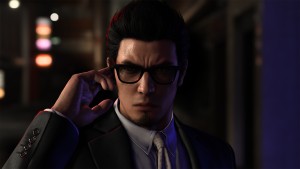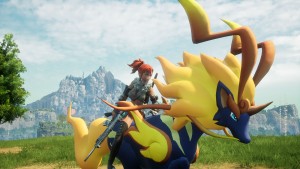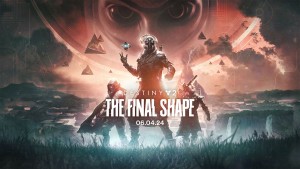Final Fantasy XIII-2 Review

When I think back on the Final Fantasy series, my favorite moments are tied to the characters and the story surrounding them. Celes on the post-apocalyptic island. The return of Rydia. Sephiroth in Nibelheim. This franchise has built its following on creating memorable worlds and narrative twists that stick with gamers for years.
Final Fantasy XIII is an exception to the rule; that entry’s greatest achievement is on the battlefield, while the story is a convoluted mess. When Square Enix announced a direct sequel, I hoped that Final Fantasy XIII-2 would repair the broken half of that equation, elevating the narrative to reach the heights attained by the outstanding battle system. Apparently, I expected too much.
Gamers are willing to forgive one mistake, but after completing FF XIII-2 (after about 30 hours), I’m worried that absurd storytelling is the future of the series. This game takes the lamest characters from the last entry (like Serah and Hope) and puts them center stage alongside an annoying moogle and new protagonist Noel. Meanwhile, the best characters (like Lightning and Fang) are relegated to background and cameo roles.
The plot surrounds the cast with an anything-goes premise focused on time travel. This is where things get really bonkers; time-travel and alternate realities are easy excuses to have a bunch of crazy stuff happen (or not happen) whenever it’s convenient. Why is that giant flan blocking my path? Why is that person acting strangely? Here’s a hint: the answer to almost every mystery in the game is “a time paradox did it.” This catch-all crutch makes it impossible to get invested in the characters or their actions. You just need to detach yourself and say “Okay, whatever,” and go along with it.
To make matters worse, you aren’t even getting a complete story. The canonical ending (there are multiple other “what if” endings) concludes with the words “to be continued,” and it’s not a scenario likely to be resolved with future DLC. After the credits, I sat in disbelief, wondering if I had done something wrong or somehow missed the true ending. I didn’t. Square Enix intentionally left the story incomplete. The announcement of Final Fantasy XIII-3 is inevitable.
I know I’m dwelling on the negative here, but storytelling is an integral part of the RPG genre, and FF XIII-2 screws it up at almost every turn. The saddest part is how that disaster is going to mark this title in fans’ memories, because FF XIII-2 is phenomenal in other ways. I’m not just saying that to temper my harsh comments about the story; practically every other part of the game is excellent, to the point that I’m looking forward to playing it again in spite of my disappointment in the plot.
The combat of FF XIII returns in a familiar yet improved form, resulting in my new favorite battle system in the Final Fantasy series. Fights require a satisfying mix of strategic management and direct control, forcing you to switch your tactics and adapt to changing conditions. Quickly shift to a defensive paradigm when a boss is about to use a powerful attack, or use a buffing/debuffing paradigm to prepare for a long battle. It’s a little easier than the last one, but remains fun and fast-paced, without the minor annoyances that got in the way in FF XIII (see sidebar).
The biggest addition to battle is monster collection, which isn’t just an optional side-activity. You’ll always have Noel and Serah in your party, and the third slot is occupied by a monster that you’ve caught by defeating (no Pokéballs necessary). Each monster has a role that you can level up and use to build your paradigms. For instance, Feral Behemoths are commandos, Blue Chocobos are ravagers, and Cait Siths are medics. You need to consider these roles along with Serah’s and Noel’s aptitudes when forming your paradigms. This adds a level of customization and versatility that you didn’t have with your party before. Plus, finally obtaining a powerful monster that you’ve been hunting delivers an extremely satisfying thrill.
Among the most prominent criticisms of FF XIII was its linearity, and the team clearly sought to rectify that in the sequel. With a few exceptions, you control how and when you progress through the main quest with the Historia Crux. The Historia Crux lets you travel to about 10 different areas, but many have past, present, and alternate incarnations that you can unlock. Certain mission-critical areas must be completed, while others are optional and often contain cool sidequests, rewards, and cameo appearances. If you get bored or frustrated, you can always return to the Historia Crux and try something else. The only limiting factor is that you need special items – Wild Artefacts – to unlock optional zones, and they are rare and often hidden. Even so, I loved the newfound freedom that the Historia Crux allows.
With the linearity issue handled, smaller concerns from FF XIII are also addressed in FF XIII-2. The artificial level caps on the Crystarium have been removed, so you don’t need to worry about hitting a wall until post-game. To that point, you can keep playing after the credits roll, continuing to level your characters, play through undiscovered areas, and collect monsters. Though you won’t find a true new game plus mode, you can reset individual areas once you’ve cleared them in order replay their stories. The ability to save anywhere is handy, and the cinematic action events and conversation options add more life to what used to be static cutscenes. These are all minor improvements, but they add up to a highly polished and more streamlined gameplay experience.
Listening closely to fan feedback can be dangerous for developers, since gamers have different – and often contradictory – opinions of what needs improvement. Final Fantasy XIII was a divisive entry in the series; from the story to the battles, every element of the game had its champions and detractors. In most respects, the team at Square Enix did a great job singling out and addressing the chief problems. Progression is player-driven, combat is even more entertaining, and an array of other adjustments makes it one of my favorite RPGs from a mechanical perspective. I just want all of that integrated with a story that isn’t laughable and borderline insulting, and that’s where Final Fantasy XIII-2 falters.
– Party leader death no longer means game over
– Annoying paradigm shift animations are gone
– Paradigms can be tuned to focus on single or multiple targets
– Serah and Noel each learn all six classes
– No more summons that turn into vehicles
– Shroud items (like Aegisol) have been removed
– The concept of TP is gone


























